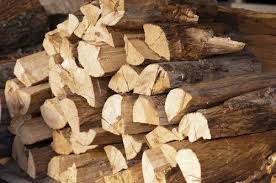
Introduction
Choosing the right type of oak firewood involves considering factors such as moisture content, burning efficiency, and overall performance. Seasoned dried and kiln-dried oak firewood are two common options, each with its own set of characteristics. in this article we will talk about Season Dried vs. Kiln Dried Oak Firewood. Let’s delve into the differences between these types to help you make an informed decision.
Season Dried Oak Firewood
Seasoned dried oak firewood is naturally dried over an extended period, typically outdoors, allowing it to reach equilibrium with the surrounding humidity. This traditional method involves splitting the wood and exposing it to air and sunlight. The seasoning process takes several months, often up to a year, depending on environmental conditions.

Pros of Season Dried Oak Firewood:
Cost-Effective:
Season dried oak firewood is often more cost-effective than its kiln-dried counterpart. The extended drying period occurs naturally, reducing the need for energy-intensive kiln drying processes.
Aroma and Flavor:
For those using oak for smoking meats, seasoned dried oak can impart a distinctive and natural flavor. The slow drying process allows the wood to develop a rich aroma that enhances the taste of grilled or smoked foods.
Low Environmental Impact:
Season drying relies on natural elements, making it an environmentally friendly option. This method minimizes energy consumption and greenhouse gas emissions associated with kiln drying.
Cons of Season Dried Oak Firewood:
Longer Drying Time:
The extended drying time required for seasoned dried oak can be a drawback for those seeking immediate availability. Planning ahead is crucial to ensure well-dried firewood.
Inconsistent Moisture Content:
As seasoning occurs outdoors, the moisture content of seasoned dried oak can vary depending on weather conditions. This variability may impact the wood’s burning efficiency.
Kiln Dried Oak Firewood
Kiln drying involves placing the oak wood in a controlled environment, typically a large oven or kiln, to accelerate the drying process. This method allows for a more rapid reduction of moisture content compared to traditional seasoning.
Pros of Kiln Dried Oak Firewood:
Rapid Drying:
Kiln drying significantly reduces the drying time compared to natural seasoning. This results in firewood with lower moisture content, promoting efficient and clean burning.
Consistent Moisture Levels:
Kiln drying provides more control over the drying environment, leading to firewood with consistent moisture content. This predictability can enhance the overall performance of the wood.
Convenient and Readily Available:
Kiln-dried oak is often available year-round, making it a convenient option for those who require firewood on short notice.
Cons of Kiln Dried Oak Firewood:
Higher Cost:
The energy-intensive nature of kiln drying can result in higher production costs, making kiln-dried oak firewood potentially more expensive than seasoned dried alternatives.
Potential for Reduced Flavor:
For those using oak for smoking, some argue that kiln-dried wood may lack the depth of flavor achieved through the slower seasoning process.
Frequently Asked Questions (FAQs)
1. What is the Difference Between Seasoned and Kiln-Dried Oak Firewood?
Seasoned oak firewood is left to dry naturally over an extended period, typically outdoors, allowing it to reduce moisture content through exposure to air and sunlight. Kiln-dried oak firewood, on the other hand, undergoes a controlled drying process in a kiln, ensuring a faster and more uniform reduction of moisture content.
2. Is Kiln-Dried Oak Firewood Better Than Seasoned Oak Firewood?
The choice between kiln-dried and seasoned oak firewood depends on specific needs. Kiln-dried firewood generally has a lower moisture content, making it easier to ignite and producing a cleaner burn. Seasoned firewood, while taking longer to dry, may offer a more traditional and natural experience. Both types can be suitable, depending on factors such as convenience, burn preferences, and intended use.
3. Does Kiln-Dried Oak Firewood Burn Hotter?
Kiln-dried oak firewood often burns hotter than seasoned firewood due to its lower moisture content. Lower moisture levels lead to more efficient combustion, generating higher temperatures and increased heat output. This makes kiln-dried oak a preferred choice for those seeking a robust and consistent source of heat, especially in heating appliances like wood-burning stoves.
4. Can Seasoned Oak Firewood Be Used in Wood-Burning Stoves?
Yes, seasoned oak firewood can be used in wood-burning stoves. However, it’s crucial to ensure that the firewood is adequately seasoned with a moisture content below 20%. Using well-seasoned wood helps prevent excessive smoke, creosote buildup, and inefficient burning. Regularly check and maintain your wood-burning stove, following the manufacturer’s guidelines for optimal performance.
5. How Long Does it Take to Season Oak Firewood?
The time required to season oak firewood can vary based on factors like climate, storage conditions, and log size. In general, oak firewood may take six months to two years to season properly. During this period, it’s essential to stack the wood in a well-ventilated area, keeping it elevated from the ground to facilitate air circulation.
6. Is Kiln-Dried Oak Firewood Environmentally Friendly?
While the kiln-drying process consumes energy, it is considered more environmentally friendly than burning unseasoned or wet firewood. Kiln drying reduces the emission of pollutants during combustion, contributing to cleaner air. However, the environmental impact also depends on the energy source used in the kiln-drying process. Some kilns use sustainable energy, further enhancing the eco-friendly aspect.
7. Can Kiln-Dried Oak Firewood Absorb Moisture After Drying?
Kiln-dried oak firewood, if exposed to high humidity or rain, can absorb moisture and lose some of its dryness. It’s crucial to store kiln-dried firewood in a dry place or cover it to prevent reabsorption of moisture. Proper storage ensures that the firewood maintains its low moisture content, optimizing its burning efficiency.
Conclusion
Both seasoned dried and kiln-dried oak firewood have their merits and drawbacks. The choice between the two depends on individual preferences, specific needs, and the intended use of the firewood. Whether you prioritize cost-effectiveness, environmental impact, or convenience, understanding the distinctions between these types of oak firewood will guide you towards selecting the option that best suits your requirements.